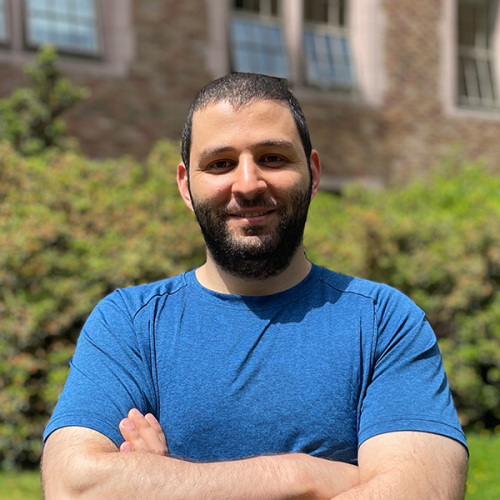Amy Sprague
October 22, 2024
A&A PhD student Mohammad Al-Jarrah combines machine learning and optimal transport theory to enhance uncertainty management in autonomous systems.
Listen to this story:

Mohammad Al-Jarrah
From self-driving cars navigating complex traffic to smart energy grids adapting to weather events and robotic surgical assistants handling unexpected situations, autonomous systems face numerous challenges in unpredictable real-world scenarios. Mohammad Al-Jarrah, an A&A Ph.D. student, has an innovative solution to make these systems safer and more reliable: combining machine learning with a sophisticated mathematical concept called optimal transport theory.
"Our research is focused on accurately quantifying the uncertainties in autonomous systems," explains Al-Jarrah, an A&A Ph.D. student whose work is funded by the National Science Foundation. "The evolution of aerospace technologies underscores a growing reliance on uncertain sensory data and deployment in uncharted environments. This matters because as aerospace systems grow in complexity, mastering the art of navigating uncertainties becomes crucial for safety and innovation."
At the heart of Al-Jarrah's research lies the "nonlinear filtering problem" - the challenge of recursively updating the probabilistic distribution of the state of the system based on noisy measurements and complex dynamics. Basically, it’s figuring out what’s really happening when you only have imperfect information. His novel approach tackles this problem by ingeniously merging two cutting-edge fields.
“The evolution of aerospace technologies underscores a growing reliance on uncertain sensory data and deployment in uncharted environments. This matters because as aerospace systems grow in complexity, mastering the art of navigating uncertainties becomes crucial for safety and innovation.”
As Al-Jarrah explains, "Optimal transport theory gives us a sophisticated way to work with probability distributions. It introduces concepts like the Wasserstein metric, a way to measure how similar or different two distributions are while taking into account the underlying data geometry."
But optimal transport alone is not enough for real-world autonomy. That's where machine learning comes in. "We use machine learning to approximate the optimal transport map - the key to transforming probability distributions based on new data," Al-Jarrah says. "By parameterizing this map using deep neural networks, we are able to capture multi-modal and high dimensional uncertainties that prior algorithms could not handle."
In other words, Al-Jarrah's approach leverages the mathematical framework of optimal transport theory while harnessing the computational power of machine learning to make those transformations feasible and efficient for complex data.
The potential impact is significant. Al-Jarrah says, "For example, we can use our methods to design optimal and energy efficient sensing strategies to reduce uncertainties in real-time, when the system is faced with unexpected situations."
Of course, developing such innovative algorithms is no trivial task. Al-Jarrah and his faculty adviser assistant professor Amir Taghvaei must tackle a range of computational and theoretical challenges, from designing neural network architectures and training procedures to deriving rigorous mathematical error bounds.
"Creating scalable and adaptable nonlinear filtering algorithms involves a set of computational development and evaluation tasks that leverage machine learning techniques," Al-Jarrah explains. This includes algorithm design, neural network parameterization, training with advanced optimizers like stochastic gradient descent, and extensive evaluation against practical benchmarks.
"Combining rigorous theoretical analysis with practical, real-world benchmarks allows us to thoroughly evaluate our algorithms and understand their reliability for real-world applications," Al-Jarrah emphasizes.
Taghvaei weighs in on Al-Jarrah's work, "It's an ambitious undertaking, but one that could pave the way for a new era of safer autonomous technologies. Mohammad's research aims to enhance the resilience of autonomous systems, potentially revolutionizing fields from transportation and energy management to healthcare and beyond."
Go to the sources
Visit recent papers co-authored by Mohammad Al-Jarrah and Amir Taghvaei on combining machine learning with transport theory:
- Optimal Transport Particle Filters published in the 62nd IEEE Conference on Decision and Control (CDC)
- Computational optimal transport and filtering on Riemannian manifolds published in IEEE Control Systems Letters
- Nonlinear Filtering with Brenier Optimal Transport Maps published in Forty-first International Conference on Machine Learning
- Data-Driven Approximation of Stationary Nonlinear Filters with Optimal Transport Maps will appear at the 63rd IEEE Conference on Decision and Control (CDC)